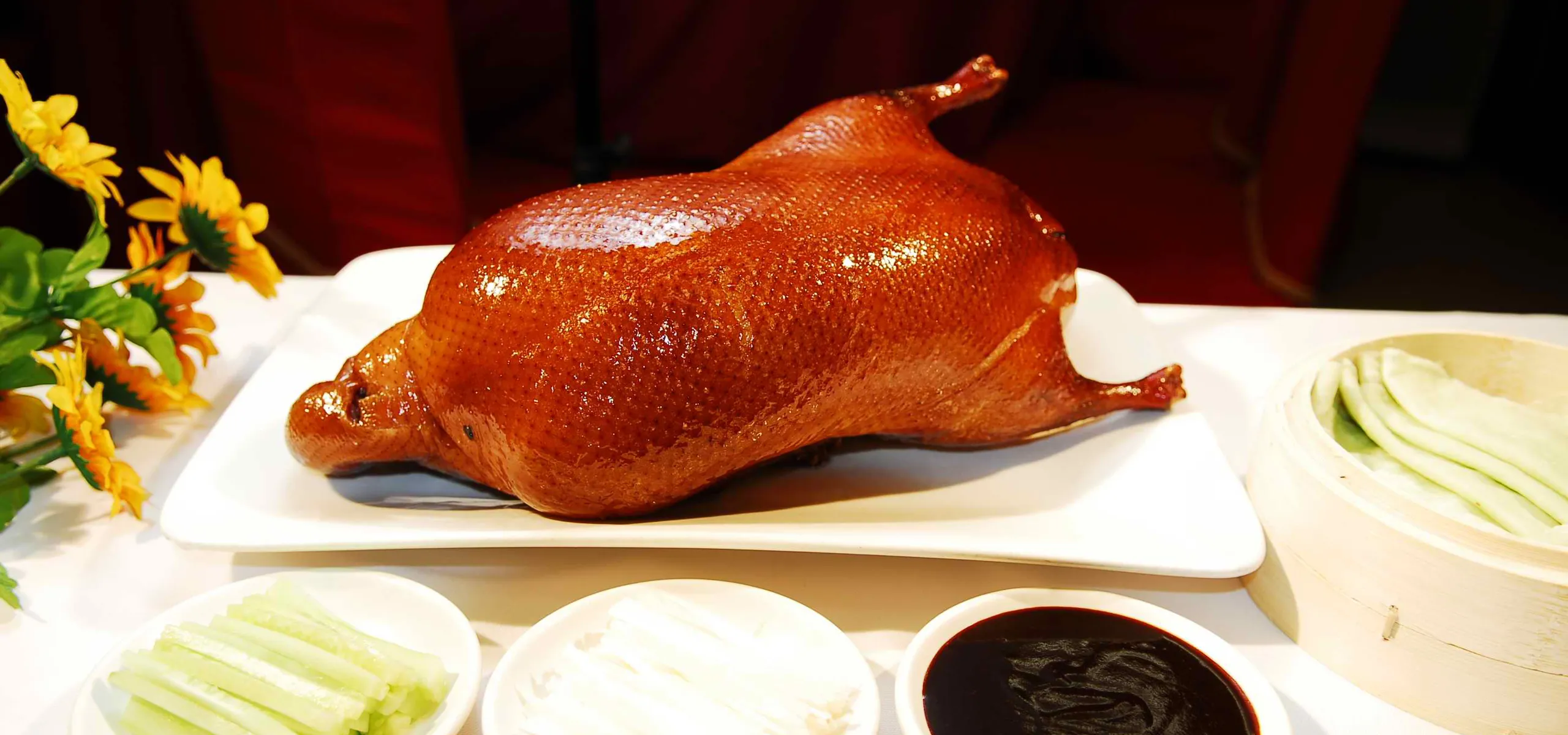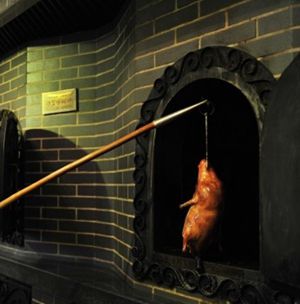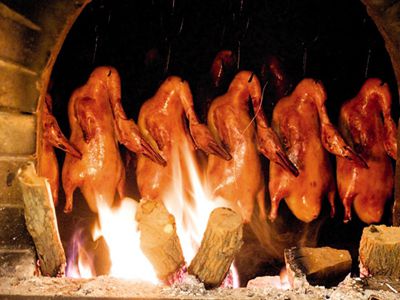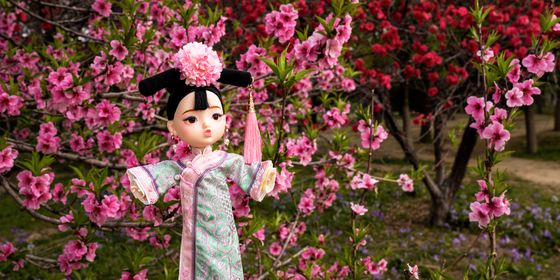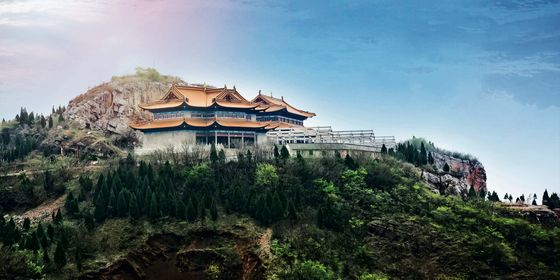A look at the long history of Peking Duck
As one of the most representative dishes of Beijing, the internationally renowned Peking Duck has a long history that dates back to the imperial era. Roast duck has been prepared in China since the Southern and Northern Dynasties. The Shizhenlu, a book about Chinese cuisine published in that time, recorded roast duck as a food served in the imperial kitchen. Characterized by its crisp skin, tender meat, and authentic flavor, Peking duck is usually eaten with scallion, cucumber, sweet bean sauce, and pancakes.
However, though its name makes it very clear that it’s “Peking” duck—using an old spelling for “Beijing”—many people claim that this dish is actually a hybrid of different regional cuisines. It’s said that the recipe for preparing the duck originated from Nanjing, the scallion slices from Shandong, and the sweet bean sauce was from Baoding, Hebei province. Today, though, it would seem Beijing has won out. Peking Duck is a household brand and an icon of Beijing and there’s nothing any of those sore losers can do about it.
Peking duck is tasty because it is prepared from the white feathered Beijing duck, a high-quality breed raised specifically for meat. It’s hypothesized that about 1,000 years ago, the founding emperor from either the Liao, Jin or Yuan dynasty discovered this species while hunting and began to raise them in the field. Newborn ducks are raised in a relatively free-range environment for the first 45 days of their lives, then force-fed four times a day for the next 15 to 20 days, which leads them to gain weight quickly. The force-feeding gives the roast duck another name, Peking Stuffed Duck (北京填鸭). The term 填鸭 (stuffed duck) is also used metaphorically to describe teaching styles based on cramming.
When the Ming Dynasty rolled around, its first capital city, Nanjing, was a city renowned historically for duck-eating, a popular custom for everyone from the emperor to the ordinary people. It was said that Zhu Yuanzhang, the first Ming emperor, “ate one roast duck per day,” so chefs in the imperial kitchen tried to invent different methods of roasting ducks. The two chief methods today are the “closed-oven” and “hung-oven” roasting.
The closed oven is built with brick and fitted with metal griddles. The oven is preheated by burning sorghum straw at the base and the duck is placed in the oven immediately after the fire burns out, allowing the meat to be slowly cooked through the heat convection within the oven.
The hung oven is designed to roast up to 20 ducks at the same time with an open fire fueled by hardwood from peach or pear trees. The ducks are hung on hooks above the fire and are roasted at a temperature of 270 °C for 30–40 minutes. While the ducks are cooking, the chef may use a pole to dangle different ducks closer to the fire every 30 seconds, so that every part of a duck can be cooked.
Today, the most famous restaurants in Beijing that serve this dish are Quanjude and Bianyifang, both of which are centuries old. Quanjude is known for using the hung-oven roasting method, while Bianyifang uses closed-oven roasting. During the Ming Dynasty, Emperor Chengzu moved the imperial capital from Nanjing to Beijing, and many duck-roasting masters came along with it. In 1416, Bianyifang, the first roast-duck restaurant in Beijing, was established in the Caishikou area.
There is another story about how this restaurant got its name. In the reign of Emperor Jiajing of the Ming dynasty, Yang Jisheng, an upright and loyal official, tried to impeach a powerful corrupt official named Yan Song at court, but failed to convince the emperor. When Yang was on his way back home, he was depressed, but suddenly, he was attracted by a strong meat flavor in the street, which came from the restaurant Bianyifang. Yang went inside and ordered a roast duck and some other dishes. The owner of the restaurant recognized this virtuous official and came to talk with him. Yang was so satisfied with the restaurant’s food and service that he brought his writing brush and wrote three-characters, “便宜坊 (bianyifang),” to present them. The boss was pleased and made Yang’s writing into a signboard to hang outside his restaurant.
But before long, Yang was framed by Yan and executed. Yan ordered Bianyifang to remove their signboard, but the owner didn’t comply. Then, Yan sent his men to pull down the signboard against the owner’s will. The owner fought against Yan’s thugs and successfully stopped them at the cost of being beaten so badly that he spit out blood. Since then, the reputation of Bianyifang spread more widely.
In 1864, when the hung-oven roast duck spread from the imperial court to the ordinary folk, Quanjude was established in Beijing. Quanjude adopted and developed the hung-oven roasting techniques and soon became famous.
By the mid-20th century, Peking Duck had become a national symbol of China. In 1971, US Secretary of State Henry Kissinger visited China in secret and met Premier Zhou Enlai. For lunch, Peking Duck was served and it become Kissinger’s favorite. Five years later, following Zhou’s death in 1976, Kissinger paid another visit to China savored the dish again. Peking Duck, at the Quanjude in particular, has also been a favorite dish for various political leaders visiting China. Premier Zhou invited his foreign guests to Quanjude to eat Peking Duck 27 times during his lifetime.
Today, Quanjude has over 1,000 branches worldwide and claims to have sold out more than 200 million ducks. In 2014, Quanjude opened a roast duck museum inside its Hepingmen branch, to mark its 150 anniversary. The museum covers around 1,200 square yards and features more than 500 duck-related items. So, next time after you enjoy a roast duck in the restaurant, don’t forget to visit this special museum.
Cover Image from xiniu.com





